-
Countries
-
Data and Analysis
-
Special Focus
-
Crisis Responses
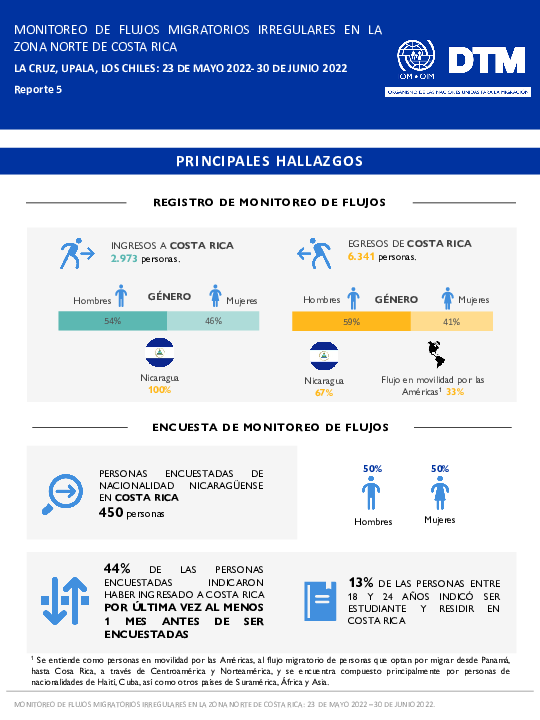
Contact
Angélica Madrigal amadrigal@iom.int
Language
Spanish
Location
Costa Rica
Period Covered
May 23 2022
Jun 30 2022
Activity
- Survey
- Registration
- Flow Monitoring
Durante el periodo de tiempo que abarca el presente informe, se logró observar un total de 9.314 cruces irregulares en los tres puntos de monitoreo de la frontera entre Costa Rica y Nicaragua. Además, de un total de 554 personas a las que se les solicita participar en la encuesta, 450 de ellas acceden, lo que significa que hubo una tasa de respuesta del 81 porciento. Estas encuestas se aplican a personas migrantes en centros de agrupación y tránsito cotidiano, como terminales de autobuses o paradas de taxis informales. La recolección de información se ha realizado todos los días de la semana, entre 8:00 a.m. y 3:00 p.m. (desde 23 de mayo al 30 de junio de 2022).

Contact
DTMUkraine@iom.int
Language
English
Location
Ukraine
Period Covered
Aug 17 2022
Aug 23 2022
Activity
- Survey
Between 17 and 23 August the International Organization for Migration (IOM) conducted the eighth round of a rapid representative assessment of the general population in Ukraine to gather insights into internal displacement and mobility flows, and to assess local needs. This general population survey serves as a preliminary source to identify areas with high humanitarian needs and to inform the targeting of response aiming to assist the war affected population. The geographical scope of the assessment covers the entire territory of Ukraine, all five macro regions (East, North, Centre, South, and the city of Kyiv), with the exception of the Crimean peninsula. The general population survey was constructed through a random digit dial (RDD) approach, and 2,001 unique and anonymous respondents aged 18 and over were interviewed using the computer assisted telephone interview (CATI) method. The estimates rely on the UNFPA population data for Ukraine, agreed upon as the common population baseline by the humanitarian community. Those currently outside Ukraine were not interviewed. For further notes on method and limitations, including IOM’s definition of internally displaced persons used for the purpose of this assessment, see page 12 In addition to this General Population Survey, data on recorded IDP presence at hromada level in Ukraine are available from IOM’s Displacement Tracking Matrix Baseline Assessment (Round 10, August 26, 2022, HDX, registration required).

Contact
DTM Yemen, iomyemendtm@iom.int
Language
English
Location
Yemen
Period Covered
Aug 21 2022
Aug 27 2022
Activity
- Mobility Tracking
IOM Yemen DTM’s Rapid Displacement Tracking (RDT) tool collects data on estimated numbers of households forced to flee on a daily basis from their locations of origin or displacement, allowing for regular reporting of new displacements in terms of estimated numbers, geography, and needs. It also tracks returnees who returned to their location of origin.
From 1 January to 27 August 2022, IOM Yemen DTM tracked 8,496 households (HH) (50,976 Individuals) who experienced displacement at least once.
Between 21 and 27 August 2022, IOM Yemen DTM tracked 63 households (378 individuals) displaced at least once. The majority of people moved into/within the following governorates and districts:
- Marib (25 HHs) – Marib City (21 HHs), Marib (4 HHs) districts. Most displacements in the governorate originated from Shabwah and Sanaa City.
- Shabwah (16 HHs) – Ayn (16 HHs) district. All displacements in the governorate originated from Marib.
- Taiz (9 HHs) – Al Qahirah (6 HHs), Al Mudhaffar (2 HHs), Salah (1 HH) districts. All displacements in the governorate were internal.
The majority of people moved from the following governorates and districts:
- Taiz (17 HHs) – Maqbanah (10 HHs), Jabal Habashi (4 HHs), At Taiziyah (2 HHs) districts.
- Marib (17 HHs) – Harib (16 HHs), Al Jubah (1 HH) districts.
- Shabwah (16 HHs) – Ataq (14 HHs), Osaylan (2 HHs) districts.
Contact
DTM Yemen, iomyemendtm@iom.int
Location
Yemen
Activity
- Mobility Tracking
- Event Tracking
Period Covered
Aug 21 2022 -Aug 27 2022
From 1 January to 27 August 2022, IOM Yemen DTM tracked 8,496 households (HH) (50,976 Individuals) who experienced displacement at least once.
Between 21 and 27 August 2022, IOM Yemen DTM tracked 63 households (378 individuals) displaced at least once. The majority of people moved into/within the following governorates and districts:
- Marib (25 HHs) – Marib City (21 HHs), Marib (4 HHs) districts. Most displacements in the governorate originated from Shabwah and Sanaa City.
- Shabwah (16 HHs) – Ayn (16 HHs) district. All displacements in the governorate originated from Marib.
- Taiz (9 HHs) – Al Qahirah (6 HHs), Al Mudhaffar (2 HHs), Salah (1 HHs) districts. All displacements in the governorate were internal.
- Taiz (17 HHs) – Maqbanah (10 HHs), Jabal Habashi (4 HHs), At Taiziyah (2 HHs) districts.
- Marib (17 HHs) – Harib (16 HHs), Al Jubah (1 HH) districts.
- Shabwah (16 HHs) – Ataq (14 HHs), Osaylan (2 HHs) districts.
Population Groups
Survey Methodology
Unit of Analysis Or Observation
Type of Survey or Assessment
Keywords
Geographical Scope
Administrative boundaries with available data
The current dataset covers the following administrative boundaries

Contact
DTM Pakistan, iomisbdtmremapteam@iom.int
Language
English
Location
Pakistan
Period Covered
Jul 02 2022
Jul 15 2022
Activity
- Flow Monitoring
IOM Pakistan collects data on the outflows of undocumented Afghan migrants at the Torkham and Chaman border crossing points in an effort to better understand the migration movements of undocumented Afghan migrants returning to Afghanistan from Pakistan. This exercise is part of the European Union funded project “Displacement Tracking Matrix Regional Evidence for Migration Analysis and Policy (DTM REMAP)”. From 02 to 15 July 2022, 1,478 undocumented Afghan migrants returned to Afghanistan from Pakistan, including 588 through the Torkham border point and 890 through the Chaman border point. During the reporting period, border authorities facilitated the return of 36 individuals due to the lack of legal documentation to remain in Pakistan. Therefore, information concerning these 36 individuals is not included in the report analysis.
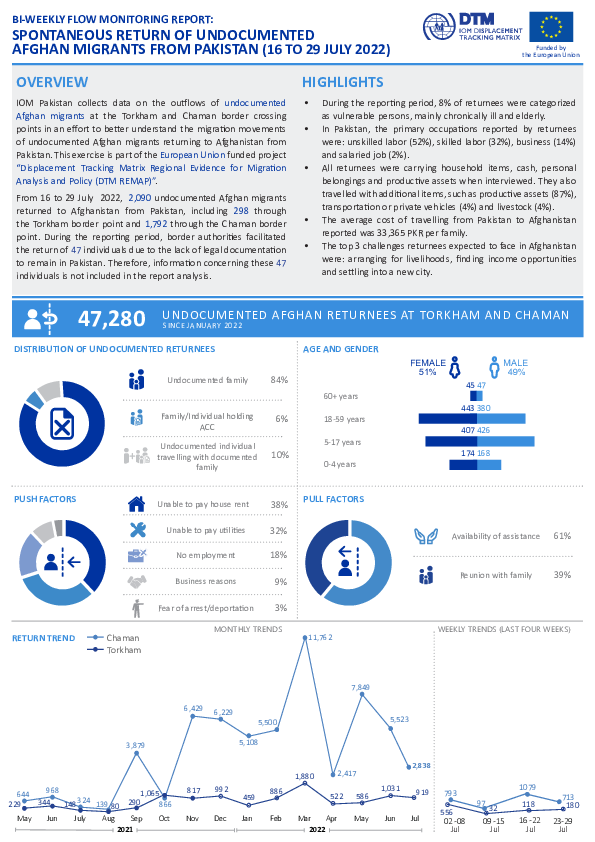
Contact
DTM Pakistan, iomisbdtmremapteam@iom.int
Language
English
Location
Pakistan
Period Covered
Jul 16 2022
Jul 29 2022
Activity
- Flow Monitoring
IOM Pakistan collects data on the outflows of undocumented Afghan migrants at the Torkham and Chaman border crossing points in an effort to better understand the migration movements of undocumented Afghan migrants returning to Afghanistan from Pakistan. This exercise is part of the European Union funded project “Displacement Tracking Matrix Regional Evidence for Migration Analysis and Policy (DTM REMAP)”. From 16 to 29 July 2022, 2,090 undocumented Afghan migrants returned to Afghanistan from Pakistan, including 298 through the Torkham border point and 1,792 through the Chaman border point. During the reporting period, border authorities facilitated the return of 47 individuals due to the lack of legal documentation to remain in Pakistan. Therefore, information concerning these 47 individuals is not included in the report analysis.
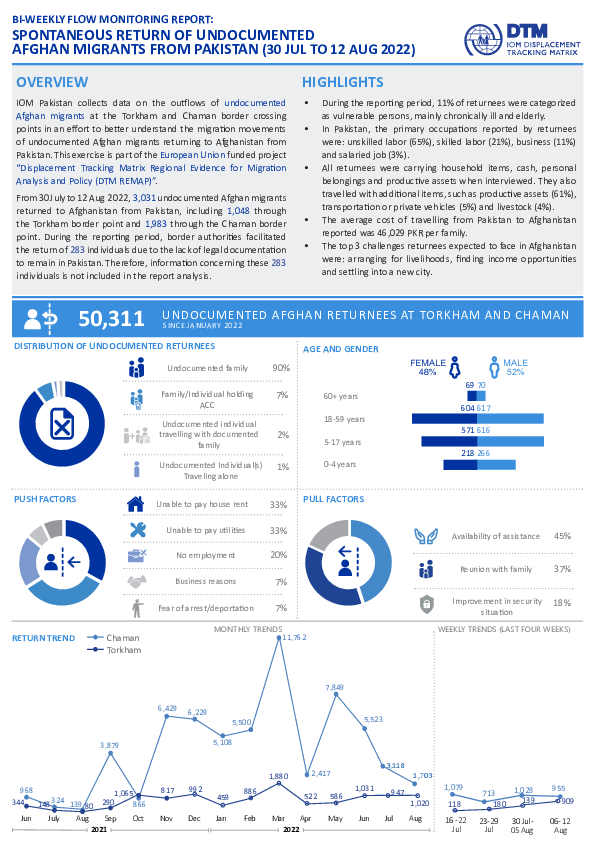
Contact
DTM Pakistan, iomisbdtmremapteam@iom.int
Language
English
Location
Pakistan
Period Covered
Jul 30 2022
Aug 12 2022
Activity
- Flow Monitoring
IOM Pakistan collects data on the outflows of undocumented Afghan migrants at the Torkham and Chaman border crossing points in an effort to better understand the migration movements of undocumented Afghan migrants returning to Afghanistan from Pakistan. This exercise is part of the European Union funded project “Displacement Tracking Matrix Regional Evidence for Migration Analysis and Policy (DTM REMAP)”.
From 30 July to 12 Aug 2022, 3,031 undocumented Afghan migrants returned to Afghanistan from Pakistan, including 1,048 through the Torkham border point and 1,983 through the Chaman border point. During the reporting period, border authorities facilitated the return of 283 individuals due to the lack of legal documentation to remain in Pakistan. Therefore, information concerning these 283 individuals is not included in the report analysis.
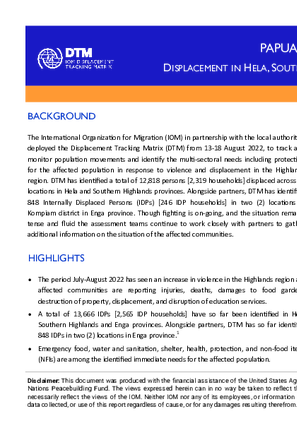
Contact
DTM Papua New Guinea, iompngmdac@iom.int
Language
English
Location
Papua New Guinea
Period Covered
Aug 13 2022
Aug 18 2022
Activity
- Mobility Tracking
- Baseline Assessment
The International Organization for Migration (IOM) in partnership with the local authorities deployed the Displacement Tracking Matrix (DTM) from 13 - 18 August 2022, to track and monitor population movements and identify the multi-sectoral needs including protection for the affected population in response to violence and displacement in the Highlands region. DTM has identified a total of 12,818 persons [2,319 households] displaced across 78 locations in Hela and Southern Highlands provinces. Alongside partners, DTM has identified 848 Internally Displaced Persons (IDPs) [246 IDP households] in two (2) locations in Kompiam district in Enga province. Though fighting is on-going, and the situation remains tense and fluid the assessment teams continue to work closely with partners to gather additional information on the situation of the affected communities.

Contact
DTM Mali, DTMMali@iom.int
Language
French
Location
Mali
Period Covered
May 01 2022
Jul 31 2022
Activity
- Flow Monitoring
Afin de mieux comprendre les tendances des mouvements transhumants et l’impact des fragilités sur les communautés transhumantes, l’OIM, à travers la Matrice de suivi des déplacements (DTM), a déployé depuis juillet 2021 l’outil de suivi de la transhumance (Transhumance Tracking Tool - TTT). Ce rapport présente les données d'alertes collectées entre mai et juillet 2022 au niveau des six points de comptage qui ont été retenus au Mali : Séguéla, Djélébou dans le cercle de Kayes; Kremis dans le cercle de Yélémané; Gavinane dans le cercle de Nioro; Korongo et Falou dans le cercle de Nara.
L’outil de suivi des alertes permet de recueillir des informations sur des événements et des mouvements soudains (précoce) ou inhabituels de bétail dans la cadre de la transhumance. Il a pour but d’obtenir des informations précises sur le nombre, le type et les caractéristiques de mouvements, qui permettraient de lancer des alertes dans l’optique de prévenir un éventuel conflit qui pourrait avoir lieu dans le cadre des mouvements de transhumance.
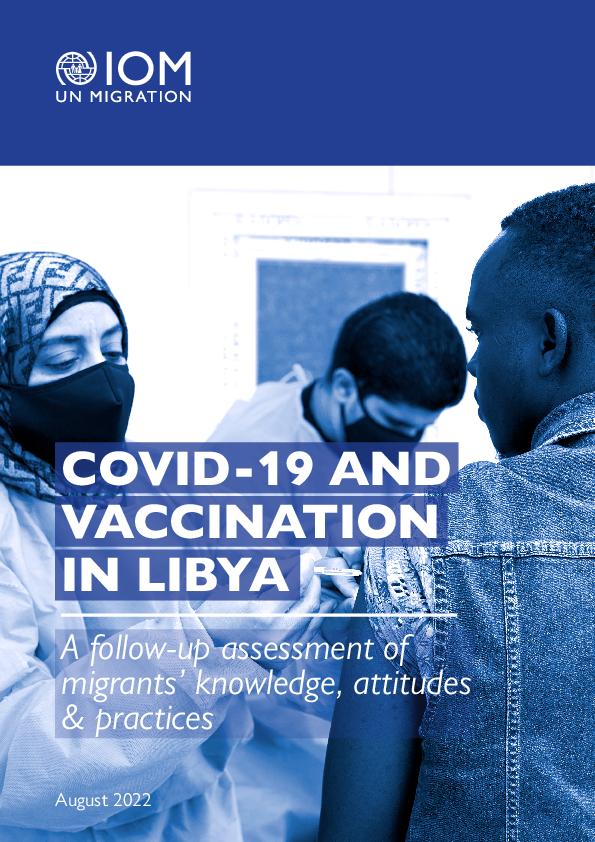
Contact
DTM Libya, DTMLibya@iom.int
Language
English
Location
Libya
Snapshot Date
Aug 29 2022
Activity
- Other
DTM Libya’s latest study "COVID-19 and vaccination in Libya: A follow-up assessment of migrants’ knowledge, attitudes and practices" aims to shed light on what migrants in Libya know, their beliefs, and practices in relation to COVID-19 with the objective to inform risk communication and community engagement (RCCE) activities. This report also provides an overview of migrants’ perception and attitude towards COVID-19 vaccines, their willingness to get vaccinated and their perceptions on potential barriers faced in accessing vaccinations in Libya.